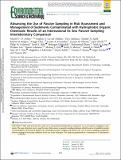Advancing the Use of Passive Sampling in Risk Assessment and Management of Sediments Contaminated with Hydrophobic Organic Chemicals: Results of an International Ex Situ Passive Sampling Interlaboratory Comparison
Author(s)
Jonker, Michiel T. O.; van der Heijden, Stephan A.; Adelman, Dave; Choi, Yongju; Flavetta, Geanna M.; Ghosh, Upal; Hale, Sarah E.; Jalalizadeh, Mehregan; Khairy, Mohammed; Lampi, Mark A.; Lao, Wenjian; Lohmann, Rainer; Lydy, Michael J.; Maruya, Keith A.; Nutile, Samuel A.; Oen, Amy M. P.; Rakowska, Magdalena I.; Reible, Danny; Rusina, Tatsiana P.; Smedes, Foppe; Wu, Yanwen; Apell, Jennifer Nicole; Burgess, Robert; Fernandez, Loretta Ana; Gschwend, Philip M; ... Show more Show less
Downloadacs.est.7b05752.pdf (2.565Mb)
PUBLISHER_CC
Publisher with Creative Commons License
Creative Commons Attribution
Terms of use
Metadata
Show full item recordAbstract
This work presents the results of an international interlaboratory comparison on ex situ passive sampling in sediments. The main objectives were to map the state of the science in passively sampling sediments, identify sources of variability, provide recommendations and practical guidance for standardized passive sampling, and advance the use of passive sampling in regulatory decision making by increasing confidence in the use of the technique. The study was performed by a consortium of 11 laboratories and included experiments with 14 passive sampling formats on 3 sediments for 25 target chemicals (PAHs and PCBs). The resulting overall interlaboratory variability was large (a factor of ∼10), but standardization of methods halved this variability. The remaining variability was primarily due to factors not related to passive sampling itself, i.e., sediment heterogeneity and analytical chemistry. Excluding the latter source of variability, by performing all analyses in one laboratory, showed that passive sampling results can have a high precision and a very low intermethod variability (<factor of 1.7). It is concluded that passive sampling, irrespective of the specific method used, is fit for implementation in risk assessment and management of contaminated sediments, provided that method setup and performance, as well as chemical analyses are quality-controlled.
Date issued
2018-02Department
Massachusetts Institute of Technology. Department of Civil and Environmental EngineeringJournal
Environmental Science & Technology
Publisher
American Chemical Society (ACS)
Citation
Jonker, Michiel T. O., Stephan A. van der Heijden, Dave Adelman, Jennifer N. Apell, Robert M. Burgess, Yongju Choi, Loretta A. Fernandez, et al. “Advancing the Use of Passive Sampling in Risk Assessment and Management of Sediments Contaminated with Hydrophobic Organic Chemicals: Results of an International Ex Situ Passive Sampling Interlaboratory Comparison.” Environmental Science & Technology 52, no. 6 (February 28, 2018): 3574–3582.
Version: Final published version
ISSN
0013-936X
1520-5851